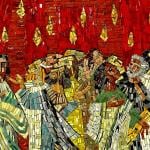According to Michael Nerlich (Ideology of Adventure), “all figures of the Greek and Latin novels of adventure are ‘involuntary’ adventurers.” Mikhail Bakhtin too (Dialogic Imagination) emphasizes that in earlier adventures “an individual can be nothing other than completely passive, completely unchanging” and function as “merely the physical subject” of events.
After the twelfth century, things change. In the Arthurian romances of Chretien de Troyes and his legions of imitators, Nerlich says, “adventures are undertaken on a voluntary basis, they are sought out (la quete de l’aventure, the quest for adventure), and this quest and hence the adventurer himself are glorified.”
Things didn’t change everywhere. Though the Nibelungenlied uses the term aventiure, the ethos is far more of the ancient, pre-Christian variety, the notion of fate rather than a chosen adventure.
This sense is partly communicated by the fact that the poem returns again and again to prophecies of disaster that is awaiting the characters. Winder McConnell (The Nibelungenlied) notes that “nine Aventiuren close with an ominous prediction . . . and portents of disaster abound. . . . Already in the first, there are no fewer than five major references to future strife. . . . By the time one reaches the concluding strophe of the first Aventiure, the integral aspects of the plot have been presented in the form of allusions or dreams . . . . ‘How terribly she avenged that on her next-of-kin who had killed him. Many a mother’s child was to die as a result of his death’” (76). Siegfried hasn’t even died yet, and we are already talking about his wife, Kriemhild, taking vengeance.
The symmetry of the arrangement of the story also lends to the sense that fate is inexorable. McConnell sees two parallel sections in the epic as a whole: “Both sections of the Nibelungenlied involve wooing missions and marriages with radical consequences. Parallel to Siegfried’s wooing of Kriemhild is Attila’s offer of marriage to the queen in the twentieth [that is, the central] Aventiure” (80). The parallels continue through the two sections: “a hero appears at Worms, either in person (Siegfried) or represented by a liegeman (Attila-Rudeger), woos Kriemhild, and, as a consequence of the subsequent union, comes into conflict with the Burgundians. Death is the ultimate result. There is a period following Siegfried’s return to Xanten with Kriemhild which could create the impression that the work will end on a happy note, just as in the second part of the epic, the time following Kriemhild’s marriage to Attila is basically one of superficial tranquility and harmony. It is the ‘calm before the storm.’ As in the first part of the Nbelungenlied, it is the ‘reuniting’ o’ Kriemhild and the Burgundians after the queen has been removed for some time from her family’s sphere of influence, which leads directly to strife and turmoil. It could be said that the entire epic is structured around Kriemhild” and her marriages (81).
McConnell (81-2) offers this more schematic outline of the epic:
“Part One
1. Kriemhild’s self-imposed exile in Worms due to her fear of leit [sorrow] caused by love.
2. Marriage to Siegfried and removal from Worms. Integration into Siegfried’s world which is a threat to Burgundian power.
Kriemhild already in conflict with Worms before her departure for Xanten. . . .
3. New meeting with Burgundians. Kriemhild aware of her considerable power and stature. Intensified conflict as a result of Kriemhild’s ruthlessness. . . .
4. Catastrophe: Death of Siegfried
Part Two
1. Kriemhild’s self-imposed exile in Worms as a result of inflicted leit.
2. Marriage to Attila and removal from Worms. Integration into Attila’s world which she turns into a threat to Burgundy.
Kriemhild in conflict with Worms before and after her departure for Gran.
3. New meeting with Burgundians. Kriemhild prepared to use power to avenge Siegfried. Various confrontations with Hagen. . . . Kriemhild ruthless and insensitive toward all.
4. Catastrophe: Death of Kriemhild and decimation of Huns and Burgundians.”
Even in the absence of the explicit notices that disaster is coming, partway through the second half of the epic, the reader would have a sickening sense that he has been through all this before, and that it will end the second time just as it did the first time, with mayhem and appalling bloodshed.











